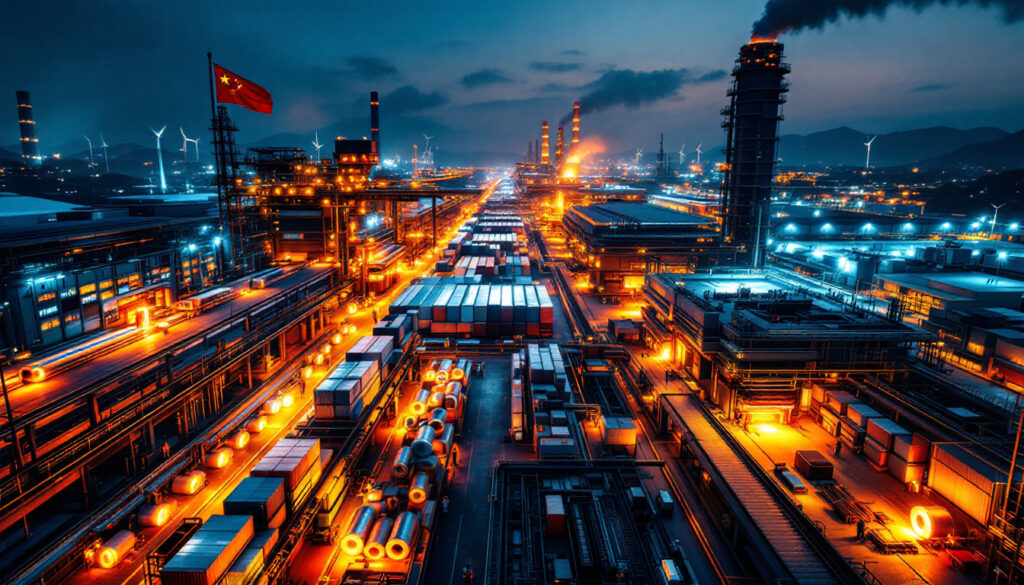What Is China's Current Aluminum Production Status?
China's aluminum production reached an unprecedented 43 million metric tons in 2024, representing a commanding 60% of global output. This dominance continues to strengthen, with first quarter 2025 production growing by 2.6% year-on-year according to data from the International Aluminium Institute. The current annualized production rate averages 44 million tons, positioning China just 1 million tons shy of the government's self-imposed 45-million-ton capacity cap.
Industry experts at AZ China highlight that capacity utilization has reached an "extremely high" 98.2%, leaving minimal room for further production increases without breaching regulatory limits. This ceiling effect is becoming increasingly evident as production growth decelerates from the 4.0% annual expansion rate observed over the previous five years.
The regional distribution of production capacity has shifted dramatically in recent years, with significant migration from coal-dependent northern provinces toward renewable energy hubs. Yunnan province, with its abundant hydroelectric resources, and Inner Mongolia, leveraging massive wind and solar potential, have become focal points for newer, more environmentally sustainable smelting operations.
How Did China Become the Dominant Aluminum Producer?
China's journey to aluminum production supremacy represents one of the most significant industrial transformations of the 21st century. Production volumes surged more than tenfold from just 4 million metric tons in 2004 to 43 million in 2024, fueled by massive state-supported investment in primary metal smelting capacity.
This dramatic expansion allowed China to capture approximately 60% of global aluminum output, fundamentally reshaping international supply chains. The dominance extends beyond primary production to downstream products, with semi-fabricated aluminum exports jumping 19% to a record 6.2 million tons in 2023 alone.
Western countries attempted to counter this industrial juggernaut through trade complaints and anti-dumping duties, particularly following the global aluminum price collapse of 2015-2016. However, these measures largely failed to stem China's export growth due to significant built-in cost advantages and vertical integration across the aluminum value chain.
The rapid expansion was supported by strategic government policies including preferential energy rates, tax incentives, and infrastructure development in key aluminum production hubs. These coordinated efforts transformed China from a minor player to the undisputed global leader in just two decades.
What Is China's Aluminum Production Ceiling?
The 45-Million-Ton Capacity Cap
Beijing established a critical 45-million-ton capacity cap in 2017 as part of broader efforts to address industrial overcapacity and environmental concerns. This ceiling remains firmly in place, recently reaffirmed in China's aluminum industry "Action Plan" for 2025-2027.
While the cap creates a nominal limitation, industry analysts note that technical possibilities exist for production to exceed these parameters through operational adjustments. Plant managers can temporarily push output above rated capacity by increasing amperage through existing equipment, though such methods face both technical and regulatory constraints.
The capacity cap has fundamentally altered China's aluminum industry dynamics. New smelters continue to be built, but regulations require offsetting closures of older, less efficient facilities. This replacement strategy allows technological advancement while maintaining overall capacity limits.
Green Transition Strategy
China's aluminum industry is simultaneously undergoing a profound green transformation. The focus has shifted toward eliminating less efficient capacity and ensuring newer smelters are powered by renewable energy resources rather than coal-fired electricity.
This transition has accelerated the migration of production capacity from traditional coal-rich provinces to emerging energy hubs. Yunnan province, with its substantial hydroelectric resources, and Inner Mongolia, showcasing massive wind and solar potential, have become preferred locations for next-generation smelting operations.
The government has established ambitious targets, including achieving 30% renewable energy for national smelter power demand by 2027. This green pivot represents both an environmental imperative and a strategic move to maintain production levels while addressing international pressure regarding decarbonisation in mining.
How Is China Adapting to Production Limits?
Recycling Expansion
With primary production approaching its regulatory ceiling, Beijing is aggressively stimulating aluminum recycling as a complementary production source. The government has established an ambitious recycling target exceeding 15 million tons per year by 2027, creating a significant secondary supply stream.
This recycling push offers multiple advantages beyond circumventing primary production caps. Recycled aluminum requires approximately 95% less energy than primary production, dramatically reducing both costs and environmental impact. The shift also decreases China's dependence on imported bauxite and alumina, enhancing supply chain resilience.
Industry leaders are investing heavily in advanced sorting technologies and processing capabilities to improve recovery rates and metal quality from an increasingly diverse scrap stream. These technological advancements are critical to meeting ambitious recycling targets.
Export Policy Changes
China has implemented strategic policy adjustments to rebalance its aluminum trade position. Most significantly, the government removed 13% tax rebate subsidies on aluminum product exports in December 2024, directly impacting the competitiveness of Chinese exports.
The impact was immediate and substantial, with export volumes declining 11% year-on-year in January and February 2025. Macquarie Bank forecasts exports to fall by approximately 8% over the full year, though a dramatic collapse remains unlikely given global commodities market insights suggest markets' dependence on Chinese products (approximately 15% of total demand).
These policy shifts suggest Chinese aluminum exports may have reached their peak, creating both challenges and opportunities across global aluminum markets. The transition represents a significant reorientation of China's aluminum strategy toward value-added production rather than volume-based export growth.
International Expansion
Facing domestic capacity limitations, Chinese producers are increasingly expanding internationally. Beijing's aluminum action plan explicitly calls for deeper cooperation with resource-rich nations, creating new avenues for continued influence over global aluminum markets.
Chinalco, China's largest aluminum producer, has established a significant presence in Guinea to convert the country's vast bauxite resources into alumina. Similarly, Shandong Nanshan Aluminium has developed substantial operations in Indonesia, including alumina refining capacity and plans for a 260,000-ton-per-year smelter.
These international ventures allow Chinese companies to bypass domestic capacity constraints while maintaining control over crucial segments of the global aluminum supply chain. The strategy ensures continued Chinese influence in aluminum markets regardless of domestic production limitations.
What Opportunities Does This Create for Western Producers?
Potential Capacity Restarts
China and peak aluminum production creates potential revival opportunities for idled Western smelting capacity. The United States currently has nearly 1 million tons of idled smelting capacity, with 25% import tariffs specifically intended to stimulate domestic restarts.
The situation in Europe is even more dramatic, with approximately half of its primary smelting capacity taken offline since 2022. This widespread shutdown followed the massive power price surge in the wake of Russia's invasion of Ukraine, which rendered many European smelters economically unviable.
Any significant restart activity remains heavily dependent on both aluminum and power prices reaching sustainable levels. While current market conditions show improvement, the threshold for widespread restarts has not yet been consistently achieved across Western markets.
New Investment Interest
Beyond restarts, there is renewed interest in constructing entirely new greenfield smelters in Western nations. Century Aluminum recently secured $500 million in government funding for what would become the first new U.S. smelter in 45 years, marking a potential turning point for domestic production.
Multinational giants are also exploring new projects, with Rio Tinto actively studying low‑carbon aluminium project possibilities in both Finland and India. These initiatives typically emphasize renewable energy integration and advanced production technologies to achieve competitive costs despite higher labor expenses.
Government support has become increasingly crucial to these projects, with many Western nations classifying aluminum as a strategic material essential for energy transition, defense applications, and economic security.
What Are the Global Market Implications?
Supply Chain Shifts
China's approaching production ceiling is triggering significant realignments in global aluminum supply chains. Western countries have developed heavy dependence on Chinese aluminum products, which currently satisfy approximately 15% of total global demand.
The reduction in subsidized exports will likely force some Western buyers to accept higher costs, potentially accelerating reshoring efforts for critical applications. However, complete disengagement from Chinese supply appears unlikely given the established infrastructure and integrated production capabilities.
Slowing Chinese production growth combined with reduced export volumes creates substantial opportunities for global producers. Markets previously dominated by Chinese exports may become viable for alternative suppliers, particularly in premium product categories.
Continued Chinese Dominance
Despite production constraints, China shows no intention of loosening its grip on global aluminum markets. The strategic focus remains on maintaining control of a metal now classified as a critical raw material by both the United States and European Union.
International expansion ensures continued Chinese influence regardless of domestic production limitations. By controlling key nodes in global supply chains—from bauxite mining to semi-finished products—China maintains leverage despite approaching its production ceiling.
This dynamic creates a complex landscape where Western producers may gain incremental opportunities while China adapts its strategy toward higher-value production and international expansion rather than simply maximizing domestic output volume.
FAQs About China's Aluminum Production
Why is China capping aluminum production?
China's aluminum capacity cap is part of a broader strategy to address industrial overcapacity, reduce pollution, and transition to greener production methods. The policy simultaneously maintains dominance in global aluminum markets while addressing environmental concerns and energy consumption challenges.
How will reduced Chinese exports affect global aluminum prices?
Reduced Chinese exports combined with production constraints will likely create tighter global supply conditions, potentially supporting higher and more stable aluminum prices. This effect may be particularly pronounced in premium product categories where non-Chinese producers hold competitive advantages.
What role will recycled aluminum play in China's future production?
With primary production approaching its ceiling, recycled aluminum will become increasingly crucial to China's overall supply strategy. The government's target of over 15 million tons of recycled production annually by 2027 would represent approximately one-third of total output, dramatically reducing energy requirements and environmental impact.
How are Western countries responding to China's aluminum dominance?
Western nations are implementing multifaceted strategies including tariffs, government funding for new capacity, critical mineral designations, and exploration of green aluminium initiative projects. These efforts aim to reduce dependence on Chinese aluminum while providing opportunities for investing in mining stocks related to aluminum production and addressing both economic security and environmental concerns.
Seeking an Edge in Mineral Discovery Investments?
Gain real-time alerts on significant ASX mineral discoveries with Discovery Alert's proprietary Discovery IQ model, transforming complex data into actionable investment insights ahead of the market. Visit Discovery Alert's discoveries page to explore how historic mineral discoveries have generated substantial returns for early investors.




